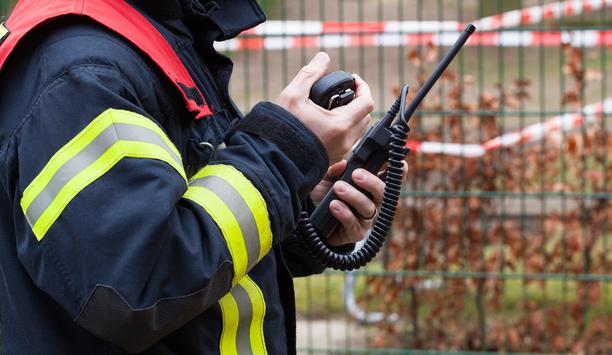In their daily lives, fire personnel must be brave, forward-thinking, and strategic when tackling fire emergencies. However, the most crucial part of a successful fire operation is the communication between the crew, the central command center, and the people in need of rescue when in mission-critical, and often life-threatening situations. Whether this location is a large-scale wildfire, a high-rise building or even a house, continuous connectivity can be the mitigating factor on success or failure when it comes to ushering people to safety.
It was estimated by the National Fire Protection Association (NFPA) that US fire crews respond to a fire situation every 24 seconds across the nation. Still the number of fire-related fatalities has dropped significantly when compared to figures from the 1970s. Of course, this is due to the more robust communications systems and high-quality fire equipment available today, but all of this relies on stable and fail-proof connectivity.
Unwavering connectivity can prevent fatalities
If fire personnel are to provide an effective and real-time response to any fire safety emergency, they require constant visibility and communication at all times. Any operation interruption, faltering connection, or unreliability can cause panic, uncertainty, and even danger. Furthermore, a robust, mobile connection allows for direct correspondence to control rooms, which can facilitate additional equipment, vehicle, and team members to be deployed. An unreliable connection presents hurdles to fire personnel as it restricts access to vital information and applications, which will inevitably hold firefighter crews back from receiving real-time data that is essential in critical situations.
Most importantly, new technology is emerging, aiming to minimize firefighter danger and increase the overall visibility of sites. The more powerful the applications are, the more bandwidth is required to support them. If a network has insufficient bandwidth capacity, real-time access to files, such as on-scene video, critical communications, and aerial imagery, may not be possible. In addition, on-the-move visibility is essential in providing firefighters with the inclusive situational awareness they require when dealing with a range of life-threatening incidents, whether this be sprawling wildfires, vehicle accidents, or domestic fire situations.
The wireless mesh that enables critical communication
Rajant Corporation has worked with many emergency personnel and equipment providers in helping them communicate reliably with its Kinetic Mesh® wireless network. Comprised of multi-frequency network nodes that solidify the connection, the network allows for complete mobility and range, enabling fire crews to communicate wherever they are without the threat of interrupted connection. It is paramount with any public safety operation that a wireless mesh is fast in transmitting real-time data and completely secure from any cybersecurity threat.
In addition to providing complete mobility, the network can support innovative equipment and wearable technology that can significantly increase safety and security in mission-critical situations. An example of this is Rajant’s partnership with communications provider Vorbeck. Equipped with Rajant’s ES1 BreadCrumb® wireless radio, the wearable Vorbeck HD4 communications harness facilitates live streaming of video, voice, and data to personnel in ‘hot zones’, these being hard-to-network areas or places with no network infrastructure. As the network can work peer-to-peer with all other Rajant BreadCrumb nodes, this extends the range of connection tenfold, keeping personnel safe and protected as they undertake their life-saving duties.
It is paramount with any public safety operation that a wireless mesh is fast in transmitting real-time data and completely secure from any cybersecurity threat. In life-threatening situations that fire personnel may face, communications need to be received without the risk of interference or latency. Rajant BreadCrumbs can be configured with multiple radio transceivers and radio frequencies, including 900 MHz, 2.4 GHz, 4.9 GHz, and 5 GHz with low-power consumption. Multi-frequency capabilities help avoid interruption, increase speed, and allow an array of applications to run simultaneously.
Ensuring comprehensive connectivity when fighting the California wildfire
In October 2019, the heat from the sun combined with winds gusting through the foothills of El Capitán Canyon in California sparked a bush fire in the desert. During the blaze, the climate in the Canyon was considered “critical fire weather” with its dry grass and wind gusts of up to 40 miles per hour. Emergency services and crews from the Santa Barbara County Fire Department, California Fire, the U.S Forest Service, and other agencies were immediately dispatched to contain the blaze before it spread. Rajant and its technology partner Dejero were enrolled after a planned public safety demonstration locally. Both companies quickly shifted to an urgent, real-life challenge.
Following this, Rajant’s BreadCrumbs and camera systems were mounted to bulldozers enabling critical local data transmission, while other situational data and mapping could be revived in the field. From a tactical response truck, Dejero was able to bridge from the field to the command post over cellular and SAT networks, during the actual emergency situation. Significantly, this allowed the firefighters manning the bulldozers to communicate in the valley, which normally is not possible. Data was then sent from the bulldozers, straight to the truck, and transmitted via the Internet connection, whereby the command control center could receive the video feed in real-time.
With Rajant and Dejero providing the connectivity needed, the operation was a success. While four hundred and twenty acres of land had burned, no structures were damaged, and, most importantly, no one was injured. By utilizing a Kinetic Mesh network, fire personnel ensure the safety of their teams. Whether they’re fighting a blaze in a house, a high-rise building, or in a vehicle, a fully mobile, rapidly deployable, and redundant wireless connection allows firefighters to fully focus on saving lives.


















